Eucla (wikipedia) is the easternmost locality in Western Australia, located in the Goldfields-Esperance region of Western Australia along the Eyre Highway, approximately 11 kilometres (7 mi) west of the South Australian border. At the 2006 census, Eucla had a population of 86. It is the only Western Australian location on the Eyre Highway that has a direct view of the Great Australian Bight due to its position immediately next to the Eucla Pass – where the highway moves out and above the basin known as Roe Plains that occurs between the Madura and Eucla passes.
History
The name Eucla is believed to originate from an Aboriginal word “Yinculyer” which one source gives as referring to the rising of the planet Venus. It was first used by Europeans for the area at some point before 1867.
In 1841, Edward John Eyre became the first explorer to visit the area. In 1867, the president of the Marine Board of South Australia discovered a port at Eucla, and in 1870, John Forrest camped at the location for nearly two weeks. In 1873, land was taken up at Moopina Station near the present townsite, and work commenced on a telegraph line from Albany to Adelaide. Land was set aside at Eucla for the establishment of a manual repeater station, and when the telegraph line opened in 1877, Eucla was one of the most important telegraph stations on the line. The station was important as a conversion point because South Australia and Victoria used American Morse code (locally known as the Victorian alphabet) while Western Australia used the international Morse code that is familiar today. A jetty and tram line were constructed for offloading supplies brought in by sea. The town was proclaimed a township and gazetted in 1885, and reached its peak in the 1920s, prior to the construction of a new telegraph line further north alongside the Trans-Australian Railway in 1929. In the 1890s a rabbit plague passed through the area and ate much of the Delisser Sandhills‘ dune vegetation, thus destabilising the dune system and causing large sand drifts to encroach on the townsite. The original town was abandoned, and a new townsite established about 4 km to the north and higher up on the escarpment. The ruins of the telegraph station still stand amongst the dunes, and are a local tourist attraction.
Many of the pioneer farmers and telegraph operators were buried at Eucla, but as the sand dunes encroached onto their graves, some of the headstones and plaques were removed and can now be seen at the museum at Eucla.The population of the town was 96 (82 males and 14 females) in 1898.
In 1971, worldwide media publicity came to the town after reports and photographs emerged of a half-naked blonde girl who had gone wild and lived and ran with the kangaroos, who came to be known as the “Nullarbor Nymph“. The story subsequently turned out to be a hoax cooked up by the residents of the tiny settlement.
16th March, Monday (Eucla)
We were up really early this morning (still dark) as it had started raining and we left the chairs outside so Ralph had to get up to bring them in, by that time we were wide awake so we got up had coffee and packed up ready to go when it got light. There was a great lightning display in the distance. There wasn’t too much rain at the Nullarbor roadhouse but you could see quite a bit of rain in the distance. We seemed to leave when all the trucks were leaving as well and we heard one bloke on the CB saying “We’ve only been on the road 5 minutes and we have got our first caravan”, I answered saying that we were early birds but I don’t think that they were impressed as they said nothing back – Grumpy old buggers. We had a few lookouts to stop at and the first one was absolutely spectacular, my photos are bad as we it was hazy and we were looking right into the sun so you can’t appreciate the full splendour of what we saw. The second lookout was awesome too but the first one was by far the best. The others were lookouts overlooking the cliffs so you could only see the tops of the cliffs. We had to stop at the State border (We are home) for Quarantine inspection. The guy was really nice and welcomed us home but he did climb in the van and make me open the fridge, cupboards, under the bed, commented on the Guinnes in the fridge, he checked the esky in the car and the Engel in the back to make sure that we weren’t carrying what we weren’t supposed to be carrying. We got to Eucla (we are really not sure what time because we had a change of time zones and it’s weird the way they work it because although we are in WA we change our clocks again when we get to Caiguna). The caravan park is quite nice (no water again, and coin slot showers) but we have a smidge of shade. There is no structure to bays so you ride round and round not sure where you can park or not so in the end we just found a spot next to a power outlet and decided that is where we will stay for tonight. We went to see the ruins of the old Telegraph Station which is on the dunes, apparently some days you can see it and some day you can’t because of the way the wind blows the sand in and then blows the sand away, it would have been an awful place to stay in those days. Town in Eucla is where we are staying it comprises the Caravan Park, the hotel/motel, a few houses (not much population here), a little museum, petrol station which is part of the motel and that’s it. From our site we can see the Bight, it’s in the distance but we still have a view. Tomorrow we head off for an overnighter in Cocklebiddy, we don’t think that there is much to see there so we won’t bother unhitching the van. We had some drinks with our neighbours and none of us knew what the time was since we all had to change time on our watches etc., we weren’t sure what time dinner was either so we just had drinks, it was hilarious.
ranacla
- Eucla Caravan Park – we have trees
- The Bight
- The Bight
- Linda was here with Straight Steve ????
- The Bight
- All the little swallows around our van
- The Bight
- The Bight
- The Bight
- Border village and quarantine station
- Quarantine Station
- Welcome Home 🙂
- The old Telegraph Station – Eucla
- The old Telegraph Station – Eucla
- The Nullarbor – The Bight in the background and a landing strip in the foreground
- Eucla
- Eucla
- The Nymph that wasn’t
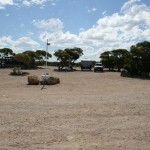
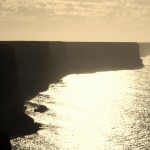


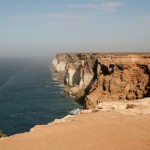
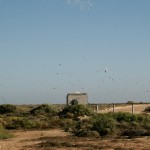
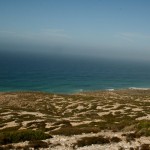
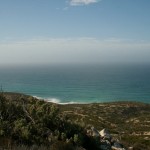

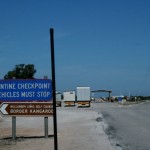


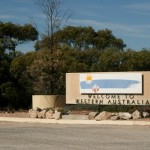




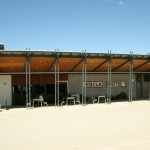

Wanted to tell you that you MUST go to Iron Knob, but I think you have already passed it?? Amazing place that was. Shame you missed it!! Enjoy your journey, and safe travels xxx